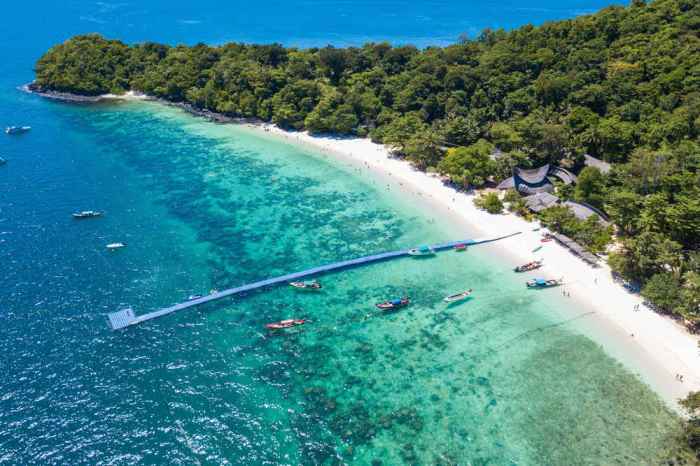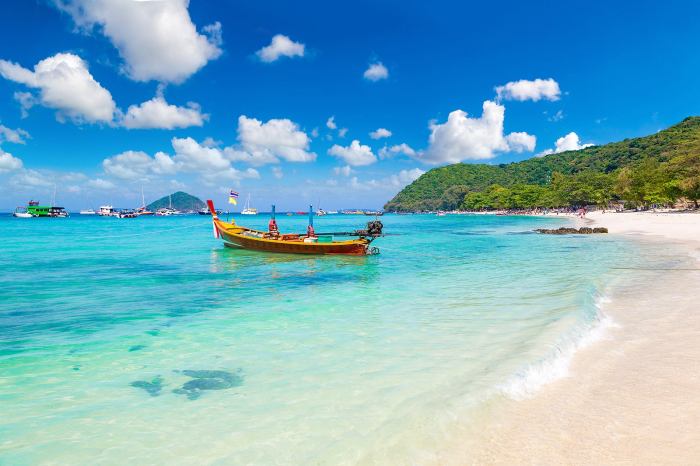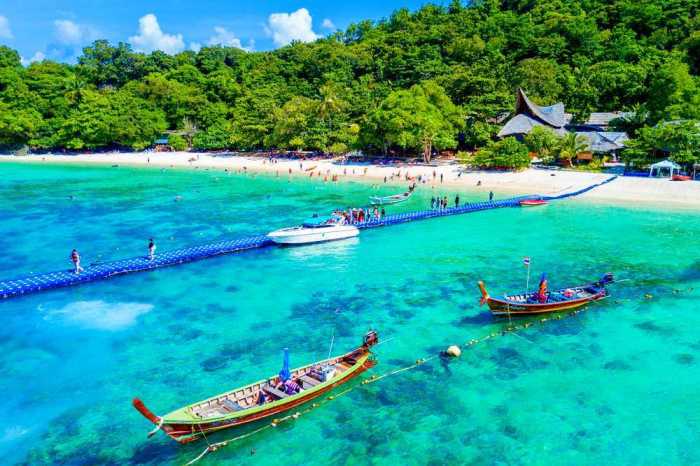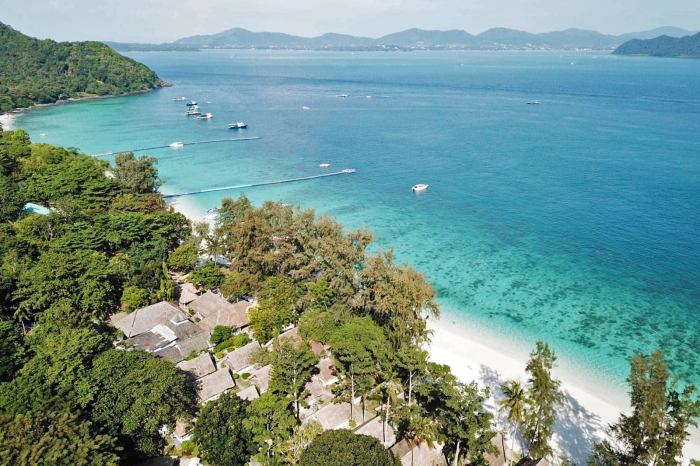Embark on an extraordinary journey to the captivating world of coral islands, where nature’s artistry paints a vibrant tapestry of life and cultural traditions intertwine. This discourse unveils the geological wonders, ecological intricacies, and profound cultural significance of these enigmatic island ecosystems.
From their geological origins to their diverse flora and fauna, coral islands stand as testaments to the Earth’s dynamic processes and the resilience of life. Their vibrant ecosystems provide sustenance and shelter to a myriad of species, showcasing the intricate web of life that thrives in these unique environments.
Definition and Overview
Coral islands, also known as atolls, are ring-shaped islands composed primarily of coral and sand. They are unique ecosystems found in tropical and subtropical regions of the world’s oceans.
Coral islands are formed through a complex geological process involving the growth and accumulation of coral reefs. Coral reefs are underwater structures made up of colonies of living coral organisms. As corals grow and die, their skeletons accumulate and form a solid base upon which the island can develop.
Formation of Coral Islands
The formation of coral islands involves several key stages:
- Coral Reef Formation:Coral reefs initially form in shallow, warm waters where sunlight can penetrate. Coral larvae attach themselves to hard surfaces, such as rocks or existing reefs, and begin to grow and form colonies.
- Uplift and Erosion:Over time, tectonic forces or changes in sea level can cause the reef to rise above the water’s surface. Once exposed to air, the reef is subject to erosion by waves and wind, which can break down the coral structures and create sand.
- Island Formation:As the reef continues to erode and accumulate sand, it can eventually form a ring-shaped island surrounded by a lagoon. The lagoon is formed when the outer reef protects the inner waters from strong waves, creating a calm and sheltered environment.
Geography and Distribution

Coral islands are distributed throughout tropical and subtropical oceans around the world. They are most commonly found in the Pacific and Indian Oceans, with a few in the Atlantic Ocean. The global distribution of coral islands is influenced by several factors, including sea surface temperatures, water clarity, and the availability of suitable substrates for coral growth.
Types of Coral Islands
There are three main types of coral islands:
- Atolls:Atolls are ring-shaped islands that surround a central lagoon. They are formed when a volcano sinks beneath the ocean surface, leaving behind a ring of coral reefs. Over time, the reefs grow upwards and eventually form an island.
- Barrier Reefs:Barrier reefs are long, narrow reefs that run parallel to the coast. They are formed when coral reefs grow outwards from the shore, creating a barrier between the ocean and the mainland.
- Fringing Reefs:Fringing reefs are coral reefs that grow directly on the shore. They are the most common type of coral reef and are found in shallow, clear waters.
The type of coral island that forms depends on the shape of the underlying substrate and the rate of sea level change. Atolls are typically found in areas where the underlying substrate is a volcanic cone or seamount. Barrier reefs are formed in areas where the underlying substrate is a continental shelf.
Fringing reefs are formed in areas where the underlying substrate is a rocky coastline.
Flora and Fauna: Coral Island

Coral islands are teeming with a diverse array of plant and animal species, each uniquely adapted to the challenges of this unique environment. From the vibrant corals that form the foundation of the island to the seabirds that soar overhead, the flora and fauna of coral islands play a vital role in the delicate balance of this fragile ecosystem.
The harsh conditions on coral islands, characterized by extreme temperatures, limited freshwater availability, and exposure to strong winds and salt spray, have shaped the evolutionary adaptations of the organisms that call it home. Many plants have developed thick, waxy leaves to reduce water loss, while animals have evolved specialized mechanisms to conserve energy and withstand the harsh conditions.
Flora
The plant life on coral islands is dominated by a variety of succulent plants, grasses, and shrubs that have adapted to the arid conditions. Some of the most common species include:
- Sea purslane ( Sesuvium portulacastrum): A succulent plant with thick, fleshy leaves that can store water.
- Beach morning glory ( Ipomoea pes-caprae): A creeping vine with heart-shaped leaves and bright pink flowers.
- Sea grape ( Coccoloba uvifera): A small tree with large, leathery leaves and edible fruit.
Fauna
The animal life on coral islands is equally diverse, with a wide range of species that have adapted to the unique challenges of the environment. Some of the most notable species include:
- Green sea turtle ( Chelonia mydas): A large sea turtle that nests on the beaches of coral islands.
- Sooty tern ( Onychoprion fuscatus): A seabird that breeds on coral islands and is known for its long migrations.
- Reef shark ( Carcharhinus melanopterus): A small shark that inhabits the coral reefs surrounding the islands.
These are just a few examples of the diverse range of plant and animal species that call coral islands home. Each organism has evolved unique adaptations that allow it to thrive in this challenging environment, contributing to the delicate balance of this fragile ecosystem.
Ecology and Conservation
Coral islands, with their intricate and diverse ecosystems, are fragile environments that face numerous threats. Understanding the delicate balance of these ecosystems is crucial for their conservation.
The coral reefs that form the foundation of these islands are home to an astonishing array of marine life. They provide shelter, breeding grounds, and food sources for countless species. However, human activities such as overfishing, pollution, and climate change pose significant risks to these ecosystems.
Conservation Efforts, Coral island
Recognizing the importance of coral islands, conservation efforts have been initiated to protect these ecosystems and their biodiversity. These efforts include:
- Establishing marine protected areas (MPAs) to limit human activities and allow coral reefs to recover.
- Implementing sustainable fishing practices to reduce overfishing and protect marine life.
- Reducing pollution through wastewater treatment and waste management.
- Raising awareness about the importance of coral islands and the threats they face.
By implementing these conservation measures, we can help preserve the delicate balance of coral island ecosystems and ensure their survival for future generations.
Cultural and Historical Significance

Coral islands hold profound cultural and historical significance for local communities worldwide. These islands have shaped the lives, traditions, and beliefs of people living in close proximity to them.
In many cultures, coral islands are considered sacred or spiritual places. They are often associated with ancestral spirits and deities and are seen as important sites for religious ceremonies and rituals.
Traditional Practices
- Fishing and Seafood Gathering:Coral islands provide sustenance to local communities through fishing and seafood gathering. The abundant marine life surrounding these islands supports traditional fishing practices and provides a vital source of food.
- Navigation and Trade:Coral islands have historically served as navigational landmarks for seafarers. They have facilitated trade and cultural exchange between different communities and have played a role in the development of maritime trade routes.
- Tourism and Recreation:In recent times, coral islands have become popular tourist destinations due to their pristine beaches, clear waters, and diverse marine life. Tourism has brought economic benefits to local communities and has helped preserve the cultural heritage associated with these islands.
Coral islands are often associated with idyllic beaches and crystal-clear waters. However, they can also be home to stunning waterfalls. One such waterfall is located in Ubud, Bali. The waterfall ubud is a popular tourist destination, and it’s easy to see why.
The falls are surrounded by lush greenery, and the water is crystal clear. Visitors can swim in the pool at the base of the falls, or simply relax and enjoy the scenery.
Tourism and Economic Impact

Tourism plays a vital role in the economy of coral islands, providing substantial revenue and creating employment opportunities. Tourists are drawn to these islands for their pristine beaches, diverse marine life, and unique cultural experiences. Tourism-related businesses, such as hotels, restaurants, tour operators, and souvenir shops, thrive on the influx of visitors.
Coral islands, with their vibrant marine ecosystems, offer breathtaking natural beauty. For a captivating blend of nature and modern architecture, consider visiting pavilion kl , an iconic shopping mall in the heart of Kuala Lumpur. After exploring the city’s urban delights, return to the serene embrace of a coral island, where the gentle sound of waves and the vibrant colors of marine life await.
Environmental and Cultural Impacts
While tourism can have significant economic benefits, it also poses potential environmental and cultural challenges. Increased tourist traffic can lead to pollution, damage to coral reefs, and depletion of natural resources. Additionally, the introduction of foreign customs and values can impact local cultures and traditions.
Exploring the vibrant coral island is a delightful experience, but if you’re looking for a break from the sun and sand, head to a shopping mall near me. You’ll find a wide variety of shops, restaurants, and entertainment options to keep you entertained.
After a day of shopping, return to the coral island to witness the breathtaking sunset, creating a perfect blend of adventure and relaxation.
To mitigate these impacts, sustainable tourism practices, such as responsible waste management, reef conservation measures, and cultural sensitivity training for tourists, are essential.
Wrap-Up

As we delve deeper into the realm of coral islands, we uncover the delicate balance of their ecosystems and the challenges they face. Conservation efforts emerge as beacons of hope, striving to preserve the pristine beauty and ecological integrity of these precious environments.
Moreover, coral islands hold profound cultural and historical significance, serving as anchors of identity for local communities. Traditional practices and beliefs entwined with these islands offer a glimpse into the rich tapestry of human interaction with the natural world.
FAQ Guide
What factors contribute to the formation of coral islands?
Coral islands are formed through the accumulation of coral debris and the subsequent cementation of these materials by calcium carbonate.
How do coral islands differ from other types of islands?
Coral islands are unique in that they are formed entirely from the remains of coral organisms, unlike other islands that may have volcanic or continental origins.
What is the significance of coral islands for marine biodiversity?
Coral islands provide critical habitats for a vast array of marine life, including fish, invertebrates, and sea turtles, contributing to the overall health and productivity of marine ecosystems.